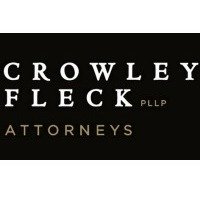Best Tax Increment Financing Lawyers in Montana
Share your needs with us, get contacted by law firms.
Free. Takes 2 min.
Or refine your search by selecting a city:
List of the best lawyers in Montana, United States
About Tax Increment Financing Law in Montana, United States
Tax Increment Financing (TIF) is an important economic development tool used by local governments in Montana and throughout the United States. It allows municipalities to fund public improvements and redevelopment projects within designated areas, often called Tax Increment Districts (TIDs) or Urban Renewal Districts. When a TIF district is created, the current property tax base is set as a baseline. Any future increases in property tax revenues, known as the "increment," generated by rising property values within the district are set aside to finance improvements and projects in that area. These funds can support infrastructure, stimulate private investment, and revitalize communities. In Montana, TIF laws are primarily found under Title 7, Chapter 15, of the Montana Code Annotated (MCA).
Why You May Need a Lawyer
The complexities of Tax Increment Financing often require specialized legal guidance. Here are several situations where seeking help from a lawyer is beneficial:
- Understanding the legal requirements for creating or modifying a TIF district
- Advising local governments, developers, or property owners about their rights and responsibilities within a TIF district
- Drafting or reviewing redevelopment plans, interlocal agreements, or development contracts
- Addressing disputes over the use of tax increments or the allocation of funds
- Navigating public hearings and compliance with public participation laws
- Ensuring adherence to state and federal regulations, including property valuation and reporting obligations
- Challenging or defending the establishment or extension of TIF districts in court
A knowledgeable lawyer can help prevent costly mistakes, facilitate agreement among stakeholders, and ensure that all legal procedures are properly followed.
Local Laws Overview
Montana’s Tax Increment Financing laws are robust and detailed. The key statutory provisions are found in the Montana Code Annotated, particularly in Title 7, Chapter 15. Montana allows for the creation of urban renewal areas, industrial districts, and targeted economic development districts financed through TIF. Some notable characteristics include:
- Local Control: Municipalities, towns, and counties have the authority to create TIF districts after adopting a resolution and an urban renewal plan.
- Project Types: Eligible projects include infrastructure improvements, demolition of blighted structures, land acquisition, environmental remediation, and streetscaping.
- Increment Calculation: When a district is created, the base taxable value is fixed. Taxes collected from increases above this base are placed in a special TIF fund for the district’s intended improvements.
- Oversight and Limitations: TIF funds must be used within the district and according to the adopted plan. There are specific guidelines for required public hearings, reporting, and duration of TIF districts.
- Expiration: TIF districts generally expire after 15 years, but extensions are possible in certain cases.
Recent reforms have introduced additional transparency and auditing requirements to ensure responsible use of TIF revenues.
Frequently Asked Questions
What is Tax Increment Financing (TIF)?
TIF is a public financing method that uses future increases in property taxes generated within a designated district to pay for current improvements in that area.
Who can establish a TIF district in Montana?
Cities, towns, and counties in Montana can establish TIF districts through a formal process that includes adopting an urban renewal or industrial development plan.
What types of projects can TIF funds support?
TIF funds can be used for public infrastructure, demolition and redevelopment, environmental remediation, land acquisition, and other projects that align with the approved plan.
How long does a TIF district last in Montana?
A TIF district typically operates for up to 15 years, but the term can be extended under certain conditions as allowed by state law.
Do property owners in a TIF district pay higher taxes?
Property owners pay taxes at the same rates as others in the city or county. The difference is that the increase in tax revenue due to rising property values is funneled into the TIF fund.
How is the base value for a TIF district determined?
The base value is the assessed value of properties within the district at the time the district is created. This figure is used to calculate future increments.
Can TIF funds be used outside the district?
No, TIF funds must be used within the boundaries of the designated district and for projects listed in the approved urban renewal or development plan.
How are TIF districts regulated and monitored in Montana?
TIF districts are subject to public hearing requirements, annual financial reporting, and state audits. Local government boards typically oversee compliance.
What is the process for dissolving a TIF district?
A TIF district can be dissolved by a resolution of the local government when its financial obligations are met, or upon reaching its expiration date. Remaining funds are distributed as prescribed by law.
What legal challenges are common with TIF districts?
Common challenges include disputes over project eligibility, allocation of funds, perceived impact on school funding, and procedural errors in establishing or amending districts.
Additional Resources
If you need more information about Tax Increment Financing in Montana, consider consulting the following resources:
- Montana Department of Commerce
- Montana Department of Revenue
- Local city and county planning or economic development offices
- Montana Code Annotated (Title 7, Chapter 15)
- Montana League of Cities and Towns
- Local bar association or professional legal organizations specializing in municipal or public finance law
Next Steps
If you believe you need advice or representation regarding Tax Increment Financing in Montana, start by gathering all documents and information about the TIF district in question, such as maps, ordinances, and redevelopment plans. Schedule a consultation with a lawyer experienced in municipal finance or land use law. Bring your questions and supporting materials to your initial meeting so the attorney can fully assess your situation. Many local legal aid organizations and bar associations offer referrals or consultation services to help you find the right professional for your needs. Taking prompt action ensures your interests are adequately represented and helps navigate the complexities of Montana’s TIF laws confidently.
Lawzana helps you find the best lawyers and law firms in Montana through a curated and pre-screened list of qualified legal professionals. Our platform offers rankings and detailed profiles of attorneys and law firms, allowing you to compare based on practice areas, including Tax Increment Financing, experience, and client feedback.
Each profile includes a description of the firm's areas of practice, client reviews, team members and partners, year of establishment, spoken languages, office locations, contact information, social media presence, and any published articles or resources. Most firms on our platform speak English and are experienced in both local and international legal matters.
Get a quote from top-rated law firms in Montana, United States — quickly, securely, and without unnecessary hassle.
Disclaimer:
The information provided on this page is for general informational purposes only and does not constitute legal advice. While we strive to ensure the accuracy and relevance of the content, legal information may change over time, and interpretations of the law can vary. You should always consult with a qualified legal professional for advice specific to your situation.
We disclaim all liability for actions taken or not taken based on the content of this page. If you believe any information is incorrect or outdated, please contact us, and we will review and update it where appropriate.
Browse tax increment financing law firms by city in Montana
Refine your search by selecting a city.
















